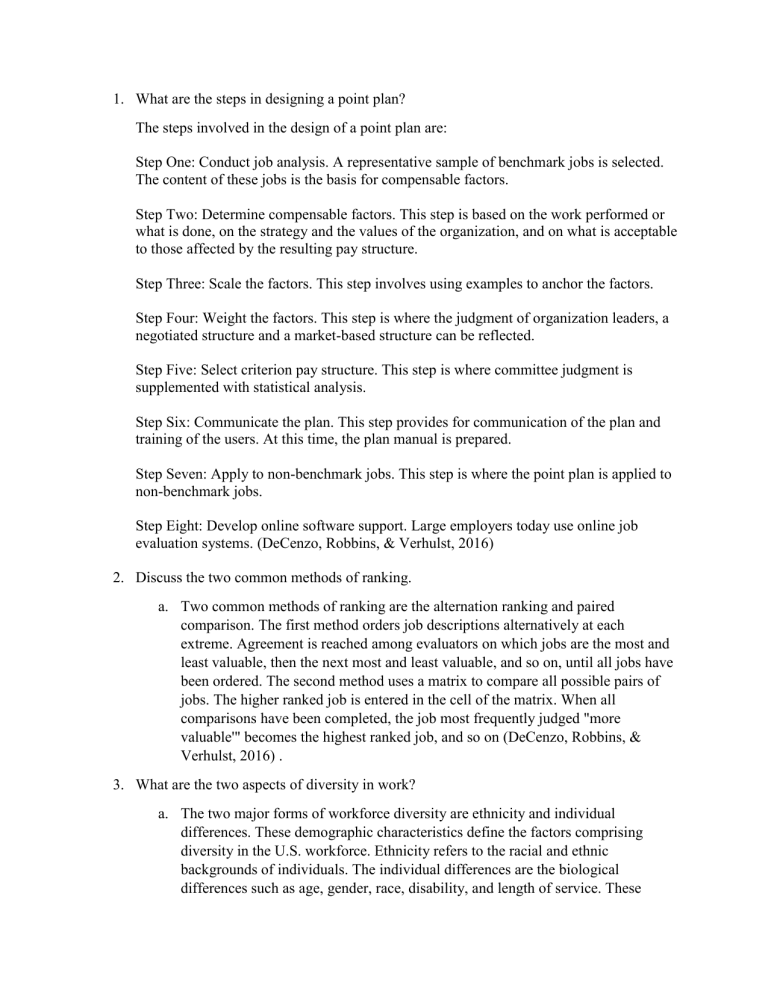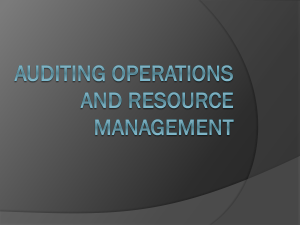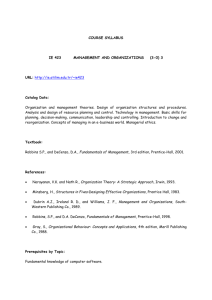
1. What are the steps in designing a point plan? The steps involved in the design of a point plan are: Step One: Conduct job analysis. A representative sample of benchmark jobs is selected. The content of these jobs is the basis for compensable factors. Step Two: Determine compensable factors. This step is based on the work performed or what is done, on the strategy and the values of the organization, and on what is acceptable to those affected by the resulting pay structure. Step Three: Scale the factors. This step involves using examples to anchor the factors. Step Four: Weight the factors. This step is where the judgment of organization leaders, a negotiated structure and a market-based structure can be reflected. Step Five: Select criterion pay structure. This step is where committee judgment is supplemented with statistical analysis. Step Six: Communicate the plan. This step provides for communication of the plan and training of the users. At this time, the plan manual is prepared. Step Seven: Apply to non-benchmark jobs. This step is where the point plan is applied to non-benchmark jobs. Step Eight: Develop online software support. Large employers today use online job evaluation systems. (DeCenzo, Robbins, & Verhulst, 2016) 2. Discuss the two common methods of ranking. a. Two common methods of ranking are the alternation ranking and paired comparison. The first method orders job descriptions alternatively at each extreme. Agreement is reached among evaluators on which jobs are the most and least valuable, then the next most and least valuable, and so on, until all jobs have been ordered. The second method uses a matrix to compare all possible pairs of jobs. The higher ranked job is entered in the cell of the matrix. When all comparisons have been completed, the job most frequently judged "more valuable'" becomes the highest ranked job, and so on (DeCenzo, Robbins, & Verhulst, 2016) . 3. What are the two aspects of diversity in work? a. The two major forms of workforce diversity are ethnicity and individual differences. These demographic characteristics define the factors comprising diversity in the U.S. workforce. Ethnicity refers to the racial and ethnic backgrounds of individuals. The individual differences are the biological differences such as age, gender, race, disability, and length of service. These differences have been studied to determine their association with job performance, job satisfaction, turnover, and other concerns of organizational management (DeCenzo, Robbins, & Verhulst, 2016). 4. What are the characteristics of a benchmark job? a. The contents are well-known, relatively stable, and agreed upon by the employees involved. The supply and demand for these jobs are relatively stable and not subject to recent shifts. They represent the entire job structure under study. A majority of the work force is employed in these jobs. 5. What is the relevance of flexibility in skill-based plans? a. Skill-based plans allows matching employees to change workflow. For example, when its business on front-line at McDonalds, the company can move employees to the registers and dining room to clean. After it slows down, they can move employees back to normally stationed areas (DeCenzo, Robbins, & Verhulst, 2016). 6. What is the relevance of certification in a multiskill system? a. Multiskill system - acquiring new knowledge related to job increases pay Pay increases occur when employees receive certification of new skills. For example, Balzers Tool Coating focuses on increasing administrations skills and increasing there pay as well (DeCenzo, Robbins, & Verhulst, 2016). 7. How do modern organizations analyze work processes? a. the work is analyzed with an eye toward competitiveness & success. routine work ( transactional work) is separated from more complex work ( tacit work) the more routine work generates lower revenues & requires less knowledge once fragmented, work processes can be rebounded into new, different jobs, pay structures based on each person's skills/ knowledge/ experience offer flexibility to align talent with continuously re designed work places. Watch the Ted Talk, “The Surprising Workforce Crisis of 2030 — and How to Start Solving it Now" athttps://youtu.be/ux1GxExRUUY 9. (Links to an external site.), and answer the following questions. a. What is the global workforce crisis that Rainer Strack mentions? Describe. The global workforce crisis that Mr. Strack discusses is that the baby boomer workforce will start to age out in year 2030. This will cause a shortage in employees in the workforce. b. Based on the results of job preferences survey, how should companies tailor their recruitment methods to address those preferences? Employers should begin to look at ways to create a work environment that not only attracts the best talent but retains their current workforce. c. How might the coronavirus pandemic impact the predicted global workforce crisis? The coronavirus had a huge impact on the predicted workforce crisis, because of the amount of individuals who lost their lives, who were in the age bands discussed. So, the pandemic jumpstarted the predictions. We have noticed a shortage already of highly skilled employees and lower skilled workers are choosing not to stay in the workforce. Bibliography DeCenzo, D. A., Robbins, S. P., & Verhulst, S. L. (2016). Fundamentals of Human Resource Management, 12th edition. Hoboken: John Wiley & Sons.


